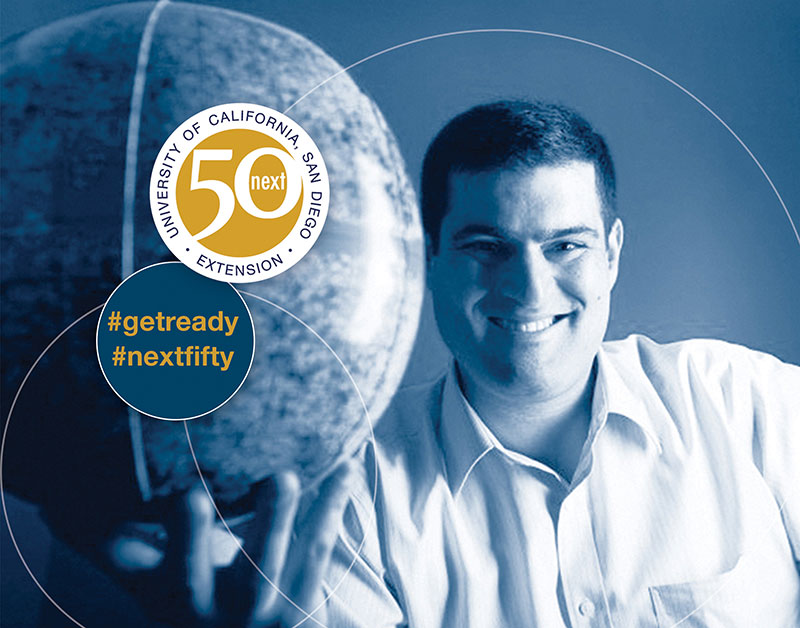12 April 2016
50 Voices of the Future: Brian Keating shares the secrets of the Universe

In honor of UC San Diego Extension's first 50 years, 50 Voices of the Future asks thought leaders about the trends, breakthroughs and social advances they foresee over the next 50 years.
Brian Keating is obsessed with studying the universe as it existed immediately after the Big Bang. And by “immediately,” he’s referring to the trillionth of a trillionth of a trillionth of a second after the bang that created it all. Understanding what happened in that instant, he says, will help us understand our universe and everything in it.
Keating, a UC San Diego professor of astrophysics, is part of a team of scientists trying to view and analyze the light emitted in the instant after the Big Bang – light that “has traveled since essentially the beginning of time to reach us.” The work of Keating and his colleagues might, among other things, help prove or disprove the existence of multiple universes. Their research has implications beyond the field of science. There are countless theological and philosophical questions that accompany their inquiry into the origins of time and space. “The very first Neanderthals must have looked up and wondered, where did everything come from?” Keating says. “And we’re finally able to start to answer those questions. This is a unique moment in human history.”
(1) Why is the work you do important?
I’m biased but I think it’s the most important work you can do as a scientist because it really subsumes all the basic laws of nature within it. To me, it’s really the most all-encompassing, multi-disciplinary field of science. It really involves all of science and even beyond.
(2) What are the influential/exciting developments happening in your field now and why?
There is a real interest to discern what the first moments of the universe were like. This light left over from the Big Bang, we can use it to look for the types of patterns predicted to originate when the actual spark that ignited the universe took place. That period of time is called inflation. We have this beautiful edifice of everything that’s happened in the universe and the laws of physics since about a second after the Big Bang. But we want to go back orders of magnitude – perhaps as many as 30 orders of magnitude farther back in time or higher in temperature. And the other portion of the work we’re trying to do is to uncover the nature of the two most mysterious substances known to science, which are dark matter and dark energy. Both of those are incredibly poorly understood. We understand we’re made up of protons and neutrons and electrons but those materials only form at most about 4 percent of the universe’s total matter and energy. So what’s the other 96 percent? That’s what we want to know. Our experiments can really trace the history and evolution of the universe and everything in it since the beginning of time, essentially. So that’s a goal. We’re trying to understand the nature of matter and energy and understand the first moments of the universe, potentially what brought it into existence.
(3) What’s the next big thing?
When I was a beginning graduate student, we didn’t know the age of the universe, whether it was 10 billion years old or 15 billion years old, which is a 50 percent uncertainty. Now we know the age of the universe to about one hundredth of a percent, something like that. With the revolution in technology, that trend is only going to continue to accelerate. My next "Big Bang" is the Simons Array, which is a set of telescopes in the high desert of northern Chile. This experiment will hopefully take us back to the very beginning...and maybe even a give a glimpse into what happened before the Big Bang . That's as big as it gets!
(4) How big of an impact will your field play in shaping the future of the San Diego region and beyond?
I never delude myself into thinking society needs people like us. It’s a privilege to get paid by the public to do what we do and to do it here in San Diego. On the other hand, it represents mankind’s deepest quest, to understand the place that humans have in the entire universe. The fact that San Diego is playing a huge role in the leading experiment in the world, I think that’s a great thing for San Diego and I’m very proud of it.
(5) Hop into your time machine…what does the future look like for this field in 50 years? How can individuals/companies get prepared for what’s next?
Fifty years from now, I hope that we’ll have significantly improved upon the sensitivity of all our instrumentation, which will reveal the composition of the universe to untold precision.
Explore the Science and Technology programs and courses that UC San Diego Extension offers including a range of certificate programs in areas such as Communications Engineering, Data Storage and Management, or learn more about astrophysics on UCSD-TV.